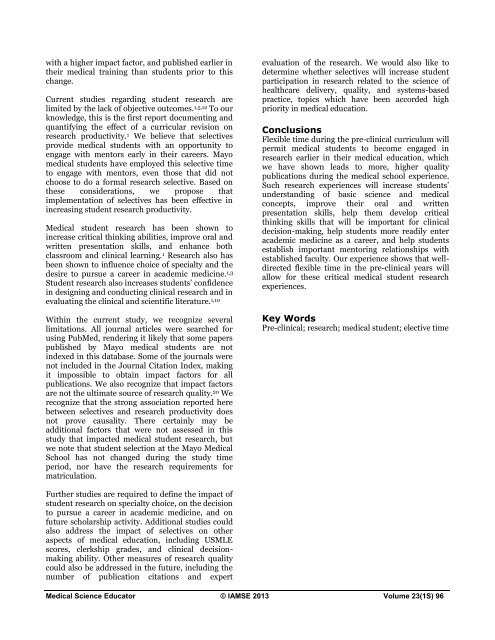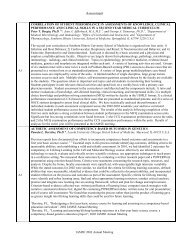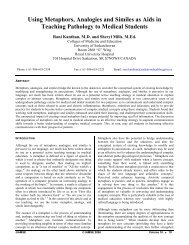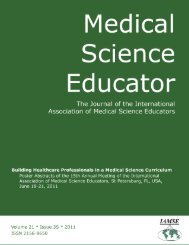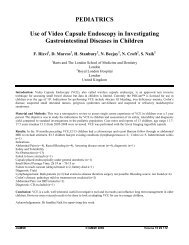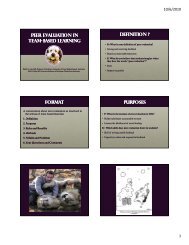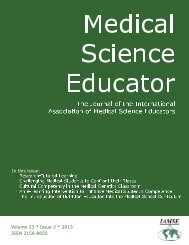with a higher impact factor, and published earlier <strong>in</strong><strong>the</strong>ir medical tra<strong>in</strong><strong>in</strong>g than students prior to thischange.Current studies regard<strong>in</strong>g student research arelimited by <strong>the</strong> lack of objective outcomes. 1,5,12 To ourknowledge, this is <strong>the</strong> first report document<strong>in</strong>g andquantify<strong>in</strong>g <strong>the</strong> effect of a curricular revision onresearch productivity. 1 We believe that selectivesprovide medical students with an opportunity toengage with mentors early <strong>in</strong> <strong>the</strong>ir careers. Mayomedical students have employed this selective timeto engage with mentors, even those that did notchoose to do a formal research selective. Based on<strong>the</strong>se considerations, we propose thatimplementation of selectives has been effective <strong>in</strong><strong>in</strong>creas<strong>in</strong>g student research productivity.<strong>Medical</strong> student research has been shown to<strong>in</strong>crease critical th<strong>in</strong>k<strong>in</strong>g abilities, improve oral andwritten presentation skills, and enhance bothclassroom and cl<strong>in</strong>ical learn<strong>in</strong>g. 1 Research also hasbeen shown to <strong>in</strong>fluence choice of specialty and <strong>the</strong>desire to pursue a career <strong>in</strong> academic medic<strong>in</strong>e. 1,3Student research also <strong>in</strong>creases students’ confidence<strong>in</strong> design<strong>in</strong>g and conduct<strong>in</strong>g cl<strong>in</strong>ical research and <strong>in</strong>evaluat<strong>in</strong>g <strong>the</strong> cl<strong>in</strong>ical and scientific literature. 1,10With<strong>in</strong> <strong>the</strong> current study, we recognize severallimitations. All journal articles were searched forus<strong>in</strong>g PubMed, render<strong>in</strong>g it likely that some paperspublished by Mayo medical students are not<strong>in</strong>dexed <strong>in</strong> this database. Some of <strong>the</strong> journals werenot <strong>in</strong>cluded <strong>in</strong> <strong>the</strong> Journal Citation Index, mak<strong>in</strong>git impossible to obta<strong>in</strong> impact factors for allpublications. We also recognize that impact factorsare not <strong>the</strong> ultimate source of research quality. 20 Werecognize that <strong>the</strong> strong association reported herebetween selectives and research productivity doesnot prove causality. There certa<strong>in</strong>ly may beadditional factors that were not assessed <strong>in</strong> thisstudy that impacted medical student research, butwe note that student selection at <strong>the</strong> Mayo <strong>Medical</strong>School has not changed dur<strong>in</strong>g <strong>the</strong> study timeperiod, nor have <strong>the</strong> research requirements formatriculation.evaluation of <strong>the</strong> research. We would also like todeterm<strong>in</strong>e whe<strong>the</strong>r selectives will <strong>in</strong>crease studentparticipation <strong>in</strong> research related to <strong>the</strong> science ofhealthcare delivery, quality, and systems-basedpractice, topics which have been accorded highpriority <strong>in</strong> medical education.ConclusionsFlexible time dur<strong>in</strong>g <strong>the</strong> pre-cl<strong>in</strong>ical curriculum willpermit medical students to become engaged <strong>in</strong>research earlier <strong>in</strong> <strong>the</strong>ir medical education, whichwe have shown leads to more, higher qualitypublications dur<strong>in</strong>g <strong>the</strong> medical school experience.Such research experiences will <strong>in</strong>crease students’understand<strong>in</strong>g of basic science and medicalconcepts, improve <strong>the</strong>ir oral and writtenpresentation skills, help <strong>the</strong>m develop criticalth<strong>in</strong>k<strong>in</strong>g skills that will be important for cl<strong>in</strong>icaldecision-mak<strong>in</strong>g, help students more readily enteracademic medic<strong>in</strong>e as a career, and help studentsestablish important mentor<strong>in</strong>g relationships wi<strong>the</strong>stablished faculty. Our experience shows that welldirectedflexible time <strong>in</strong> <strong>the</strong> pre-cl<strong>in</strong>ical years willallow for <strong>the</strong>se critical medical student researchexperiences.Key WordsPre-cl<strong>in</strong>ical; research; medical student; elective timeFur<strong>the</strong>r studies are required to def<strong>in</strong>e <strong>the</strong> impact ofstudent research on specialty choice, on <strong>the</strong> decisionto pursue a career <strong>in</strong> academic medic<strong>in</strong>e, and onfuture scholarship activity. Additional studies couldalso address <strong>the</strong> impact of selectives on o<strong>the</strong>raspects of medical education, <strong>in</strong>clud<strong>in</strong>g USMLEscores, clerkship grades, and cl<strong>in</strong>ical decisionmak<strong>in</strong>gability. O<strong>the</strong>r measures of research qualitycould also be addressed <strong>in</strong> <strong>the</strong> future, <strong>in</strong>clud<strong>in</strong>g <strong>the</strong>number of publication citations and expert<strong>Medical</strong> <strong>Science</strong> <strong>Educator</strong> © IAMSE 2013 Volume 23(1S) 96
Notes on ContributorsJUSTIN G. PEACOCK, PhD, is a third-year medicalstudent at Mayo <strong>Medical</strong> School, Mayo Cl<strong>in</strong>icCollege of Medic<strong>in</strong>e, Rochester, MN, USA.LINDSAY L. WARNER, BS, is a third-year medicalstudent at Mayo <strong>Medical</strong> School, Mayo Cl<strong>in</strong>icCollege of Medic<strong>in</strong>e, Rochester, MN, USA.LINDA B. DROZDOWICZ, BS, is a third-yearmedical student at Mayo <strong>Medical</strong> School, MayoCl<strong>in</strong>ic College of Medic<strong>in</strong>e, Rochester, MN, USA.BRAD A. MARTIN, BA, is a third-year medicalstudent at Mayo <strong>Medical</strong> School, Mayo Cl<strong>in</strong>icCollege of Medic<strong>in</strong>e, Rochester, MN, USA.RAHUL SURESH, BA, is a third-year medicalstudent at Mayo <strong>Medical</strong> School, Mayo Cl<strong>in</strong>icCollege of Medic<strong>in</strong>e, Rochester, MN, USA.BONNIE J. DENZER, BA, is an educationadm<strong>in</strong>istration coord<strong>in</strong>ator at Mayo <strong>Medical</strong> School,Mayo Cl<strong>in</strong>ic College of Medic<strong>in</strong>e, Rochester, MN,USA.ASHLEY B. WENTWORTH, BA, is a third-yearmedical student at Mayo <strong>Medical</strong> School, MayoCl<strong>in</strong>ic College of Medic<strong>in</strong>e, Rochester, MN, USA.JESSICA A. ADEFUSIKA, BS, is a third-yearmedical student at Mayo <strong>Medical</strong> School, MayoCl<strong>in</strong>ic College of Medic<strong>in</strong>e, Rochester, MN, USA.MARIA J. BACHMAN, BS, is a third-year medicalstudent at Mayo <strong>Medical</strong> School, Mayo Cl<strong>in</strong>icCollege of Medic<strong>in</strong>e, Rochester, MN, USA.JOSEPH P. GRANDE, M.D., Ph.D, is an AssociateDean for Academic Affairs at Mayo <strong>Medical</strong> School,and Professor and Consultant <strong>in</strong> <strong>the</strong> Department ofLaboratory Medic<strong>in</strong>e and Pathology, Mayo Cl<strong>in</strong>icCollege of Medic<strong>in</strong>e, Rochester, MN, USA.Author’s ContributionsJ.G.P. conducted student publication searches,analyzed <strong>the</strong> composite data, prepared <strong>the</strong> figuresand wrote <strong>the</strong> manuscript. L.L.W. conductedstudent publication searches, wrote a portion of <strong>the</strong>methods, and contributed to <strong>the</strong> discussion. B.J.D.compiled <strong>the</strong> graduation lists and additionaldegrees/research experiences for all <strong>the</strong> medicalschool years. L.B.D., B.A.M., R.S., A.B.W., J.A.A.,and M.J.B. conducted student publication searches.J.P.G. provided <strong>in</strong>tellectual guidance and reviewed<strong>the</strong> manuscript.References1. Bierer SB, Chen HC. How to measure success:<strong>the</strong> impact of scholarly concentrations onstudents--a literature review. Acad Med.[Review]. 2010 Mar;85(3):438-52.2. Re<strong>in</strong>ders JJ, Kropmans TJ, Cohen-Schotanus J.Extracurricular research experience of medicalstudents and <strong>the</strong>ir scientific output aftergraduation. Med Educ. [<strong>Letter</strong>]. 2005Feb;39(2):237.3. Chongsiriwatana KM, Phelan ST, Skipper BJ,Rhyne RL, Rayburn WF. Required research bymedical students and <strong>the</strong>ir choice of a women'shealth care residency. Am J Obstet Gynecol.[Research Support, Non-U.S. Gov't]. 2005May;192(5):1478-80.4. Gotterer GS, O'Day D, Miller BM. The EmphasisProgram: a scholarly concentrations program atVanderbilt University School of Medic<strong>in</strong>e. AcadMed. [Research Support, Non-U.S. Gov't]. 2010Nov;85(11):1717-24.5. Parsonnet J, Gruppuso PA, Kanter SL, Bon<strong>in</strong>gerM. Required vs. elective research and <strong>in</strong>-depthscholarship programs <strong>in</strong> <strong>the</strong> medical studentcurriculum. Acad Med. 2010 Mar;85(3):405-8.6. Sanford T, Chancer Z, Kiyosaki K. <strong>Medical</strong>student research at <strong>the</strong> John A. Burns School ofMedic<strong>in</strong>e (JABSOM): <strong>the</strong> Research InterestGroup. Hawaii Med J. 2010 Jul;69(7):172-3.7. Schor NF, Troen P, Kanter SL, Lev<strong>in</strong>e AS. TheScholarly Project Initiative: <strong>in</strong>troduc<strong>in</strong>gscholarship <strong>in</strong> medic<strong>in</strong>e through a longitud<strong>in</strong>al,mentored curricular program. Acad Med. 2005Sep;80(9):824-31.8. van Eyk HJ, Hooiveld MH, Van Leeuwen TN,Van der Wurff BL, De Craen AJ, Dekker FW.Scientific output of Dutch medical students.Med Teach. 2010;32(3):231-5.9. Zier K, Coplit LD. Introduc<strong>in</strong>g INSPIRE, ascholarly component <strong>in</strong> undergraduate medicaleducation. Mt S<strong>in</strong>ai J Med. 2009Aug;76(4):387-91.10. Zier K, Friedman E, Smith L. Supportiveprograms <strong>in</strong>crease medical students' research<strong>in</strong>terest and productivity. J Investig Med.[Research Support, Non-U.S. Gov't]. 2006May;54(4):201-7.11. Elwood JM, Pearson JC, Madeley RJ, Logan RF,Beaver MW, Gillies PA, et al. Research <strong>in</strong>epidemiology and community health <strong>in</strong> <strong>the</strong>medical curriculum: students' op<strong>in</strong>ions of <strong>the</strong>Nott<strong>in</strong>gham experience. J EpidemiolCommunity Health. 1986 Sep;40(3):232-5.<strong>Medical</strong> <strong>Science</strong> <strong>Educator</strong> © IAMSE 2013 Volume 23(1S) 97
- Page 4 and 5: Patient Oriented Research: The Duke
- Page 6 and 7: MEDICAL SCIENCE EDUCATORThe Journal
- Page 8 and 9: alumni continued with a full time a
- Page 10 and 11: MEDICAL SCIENCE EDUCATORThe Journal
- Page 12 and 13: In addition to the monthly core ses
- Page 14 and 15: MEDICAL SCIENCE EDUCATORThe Journal
- Page 16 and 17: encourages students to develop and
- Page 18 and 19: MEDICAL SCIENCE EDUCATORThe Journal
- Page 20 and 21: Figure 1: The average number of pub
- Page 24 and 25: 12. Green EP, Borkan JM, Pross SH,
- Page 26 and 27: in providing research opportunities
- Page 28 and 29: Figure 2: Number of projects comple
- Page 30 and 31: eing evaluated on multiple occasion
- Page 32 and 33: suggested that academic schools/dep
- Page 34 and 35: MEDICAL SCIENCE EDUCATORThe Journal
- Page 36 and 37: efficient as possible. All students
- Page 38 and 39: The layout and design of the Labora
- Page 40 and 41: effective therapy will regulate pro
- Page 42 and 43: Key WordsMedical student research,
- Page 44 and 45: 33. Darabi R, Baik J, Clee M, Kyba
- Page 46 and 47: work in a team with a faculty super
- Page 48 and 49: MEDICAL SCIENCE EDUCATORThe Journal
- Page 50 and 51: CORE COMPETENCYThe Scientific Metho
- Page 52 and 53: During Year 3, students are brought
- Page 54 and 55: APPENDIXFigure 1: Curriculum themes
- Page 56 and 57: Figure 2: Cystic Fibrosis Case Intr
- Page 58 and 59: Table 2: Medical Scholar Series Top
- Page 60 and 61: Table 3: Representative research pr
- Page 62 and 63: the M.B.Ch.B and B.Pharm. degrees r
- Page 64 and 65: Regardless of its origins, there is
- Page 66 and 67: References1. Eichbaum Q, Nyarango P
- Page 68 and 69: methods, sample size and power, use
- Page 70 and 71: Evaluation Survey by StudentsAt the
- Page 72 and 73:
DiscussionThis program was created
- Page 74 and 75:
MEDICAL SCIENCE EDUCATORThe Journal
- Page 76 and 77:
andomly divided over small groups i
- Page 78 and 79:
In our course, the example of skin
- Page 80 and 81:
MEDICAL SCIENCE EDUCATORThe Journal
- Page 82 and 83:
student/team is assigned a primaryt
- Page 84 and 85:
KeywordsResearch, Competencies, Cur
- Page 86 and 87:
conducting in-class research requir
- Page 88 and 89:
Glucose measurements are taken in s
- Page 90 and 91:
13. Basu Ray I, Henry TL, Davis W,
- Page 92 and 93:
Goals of the Research ProgramBy est
- Page 94 and 95:
Community OutcomesEach year we shar
- Page 96 and 97:
MEDICAL SCIENCE EDUCATORThe Journal
- Page 98 and 99:
AlamarBlue assay. For downregulatio
- Page 100 and 101:
development of cancer in NF1-patien
- Page 102 and 103:
coated with micro-patterns of Colla
- Page 104 and 105:
Duke Treadmill Score for Predicting
- Page 106 and 107:
and smr genes were downloaded from
- Page 108 and 109:
initial diagnosis respectively the
- Page 110 and 111:
hythm, we considered it appropriate
- Page 112 and 113:
Respiration Changes on Fowler Posit
- Page 114 and 115:
to the WHO protocol, the measure wa
- Page 116 and 117:
anesthesia techniques are safe and
- Page 118 and 119:
Spearman correlation quotient (R) a
- Page 120 and 121:
MEDICAL SCIENCE EDUCATORThe Journal
- Page 122:
International Association ofMedical
- Page 126:
MEDICAL SCIENCE EDUCATORThe Journal


